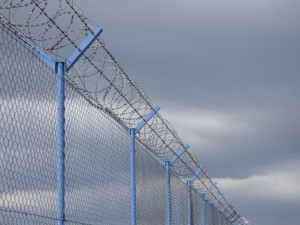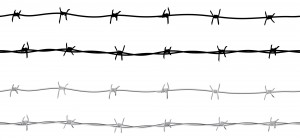Melilla and Calais are two European cities struggling to stem the flow of irregular migrants. One an enclave on the African coast, the other a port in mainland Europe, both are on irregular migration’s frontline. So, what do these two cities have in common? Can any shared lessons be drawn, based on their respective experiences? Can they tell us a tale of how not to manage migration?
Strength in numbers: l’union fait la force
 Not long after the Moroccan government decided to mount a campaign of regularisation, over 8,000 migrants have already been regularised (3,000 based on applications and another 5,000 women and children as priority cases) and are trying to make a new life in Morocco. Counter-intuitively, there has also been an increase in the number of instances of migrants trying to scale the fence en masse to make it into Melilla, a Spanish city bordering Morocco, in crowds of hundreds at a time. Indeed, only a few months ago, 400 irregular sub-Saharan migrants made it into Melilla by storming the 7 metre high border fence. It is one of several attempts that have taken place this year. This raises two main questions. First, is the new Moroccan regularisation policy unappealing, compared with the lure of a better life in Europe? Or, second, are these migrants who are attempting to cross the border unable to satisfy the criteria for regularisation (eg two years of Moroccan residence) and therefore have no option but to try their luck or face deportation?
Not long after the Moroccan government decided to mount a campaign of regularisation, over 8,000 migrants have already been regularised (3,000 based on applications and another 5,000 women and children as priority cases) and are trying to make a new life in Morocco. Counter-intuitively, there has also been an increase in the number of instances of migrants trying to scale the fence en masse to make it into Melilla, a Spanish city bordering Morocco, in crowds of hundreds at a time. Indeed, only a few months ago, 400 irregular sub-Saharan migrants made it into Melilla by storming the 7 metre high border fence. It is one of several attempts that have taken place this year. This raises two main questions. First, is the new Moroccan regularisation policy unappealing, compared with the lure of a better life in Europe? Or, second, are these migrants who are attempting to cross the border unable to satisfy the criteria for regularisation (eg two years of Moroccan residence) and therefore have no option but to try their luck or face deportation?
The answer is probably a bit of both. Some migrants are determined to make it to Europe, despite the alternative possibility of an improvement in their living conditions in Morocco through effective amnesty. Others might be willing to stay in Morocco but cannot because of the administrative inflexibility of the regularisation process and the high rate of rejection of applications (92.6 per cent in June 2014).
While these ‘storming’ strategies have been used for some time now at the Melilla border, the first organised attempt at a mass border crossing by irregular migrants in Calais took place in September 2014, when about 400 migrants attempted to storm ferries on their way to the UK. French port authorities at Calais confirmed that 85 migrants had pushed through a security gate while others climbed over fences. A further 250 migrants rushed the port security, but were stopped by police. Chris Laming, communications director at P&O Ferries, said that, "We have never seen anything like this before, even in the days of Sangatte." The number of migrants in Calais has risen rapidly in recent months, with UNHCR estimating between 1,000 and 1,400 migrants in the town and its environs now trying to enter the UK.
Finance and fences
With European media frequently depicting ‘impending invasions’ of irregular migrants, Europe has invested more and more in border control. For a decade now, the European Union has sought to control irregular migration into the region by extending its borders to Morocco and other countries in the Maghreb, repositioning them as the continent’s ‘new frontier’. A variety of mechanisms have been used to this end, from ‘mobility partnerships’ to targeted funding. Consequently, an increasing securitisation has been apparent in the development of Morocco’s migration policy.
 Spain also receives substantial funding from the European Union to combat irregular migration. Only this year, Spain received €10 million to prevent irregular migration from Morocco. A large part of the funds that Spain has received will be used to strengthen border fences, while only a small amount is to be used to fund voluntary return programmes. In November 2013, Spain also restored the barbed wire that was removed in 2007 because of the serious injuries it inflicted on those that climbed over. This time, however, they have added coils of razor wire atop the fence.
Spain also receives substantial funding from the European Union to combat irregular migration. Only this year, Spain received €10 million to prevent irregular migration from Morocco. A large part of the funds that Spain has received will be used to strengthen border fences, while only a small amount is to be used to fund voluntary return programmes. In November 2013, Spain also restored the barbed wire that was removed in 2007 because of the serious injuries it inflicted on those that climbed over. This time, however, they have added coils of razor wire atop the fence.
Similarly, the UK has recently promised £12 million (€15 million) to help France deal with irregular migrants trying to get into Britain from Calais. The UK has also agreed to give the French port the 2.75 metre high “Ring of Steel” security fence used recently at the NATO Summit in Wales, in the hope that it will deter potential irregular migrants from trying to come to the UK. These fences, according to the Home Office Immigration Minister, James Brokenshire, will replace the “inadequate fencing” currently in place at the port.
Beyond barriers
If it were the case that the higher the fence, the stronger the deterrent, then Spain would have managed by now to reduce irregular migration from Morocco with Melilla’s three high fences topped with barbed wire. So, the idea that the new, much lower fence in Calais might have a pronounced deterrent effect appears naïve. The novel ‘storming’ strategies used in Calais resemble what is happening in Melilla, which highlights two points. First, that irregular migrants’ strategies for crossing borders are continuously updated in the light of the experience of other people in similar circumstances elsewhere in the world. Second, that fencing policies are not working, as they have been used in Morocco and other parts of the world (e.g. the US-Mexico border) for decades, with no substantial decrease in the number of irregular migrants.
In the end, security-focused measures only contain rather than resolve irregular migration. What is needed instead is a continuous, Europe-wide discussion on the causes of the issue and how to tackle it in a more sustainable way. This conversation must also involve countries of transit or new settlement countries such as Morocco. Just as France feels able to make demands of the UK for upstream action to tackle irregular migration to Britain from Calais, so Morocco is entitled to make demands of Spain to address some of the problems whose symptoms appear in Melilla. Finally, European Union funds could be spent more strategically, supporting governments and civic society in source and transit countries to address irregular migration as well as to support the twin processes of return and reintegration.